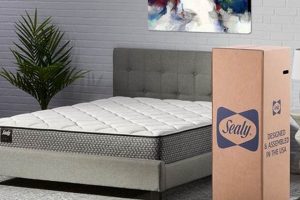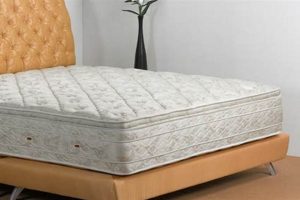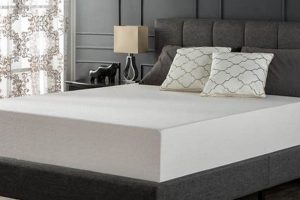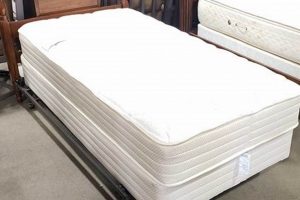The unwanted movement of a bed component from its intended position atop its foundation is a common household frustration. This phenomenon, characterized by gradual or sudden displacement, frequently disrupts sleep and necessitates constant readjustment. For example, individuals might find themselves waking to discover a portion of their sleeping surface extending beyond the supporting structure.
Addressing this issue is essential for ensuring restful sleep and prolonging the lifespan of bedding components. Stable positioning not only enhances comfort but also prevents uneven wear and tear, thereby maximizing the value of the investment in sleep-related products. Historically, solutions have ranged from makeshift remedies to specifically designed products aimed at improving surface adhesion and preventing slippage.
The subsequent discussion will delve into the primary causes of this instability, explore effective remedial strategies, and examine preventative measures designed to maintain the integrity of a bed’s configuration. These include friction enhancement techniques, structural modifications, and the selection of compatible components designed to work in unison.
Mitigating Bedding Displacement
The following are actionable strategies to address and prevent the displacement of a sleeping surface from its foundation, ensuring a more stable and comfortable sleep environment.
Tip 1: Employ Non-Slip Materials. Consider placing a non-slip mat, similar to those used for rugs, between the two surfaces. This creates increased friction, inhibiting unwanted movement.
Tip 2: Utilize Mattress Grippers. These specialized products, often adhesive-backed strips, affix to the foundation and the perimeter of the bedding component, providing a secure grip.
Tip 3: Inspect the Foundation’s Surface. A worn or damaged foundation surface can contribute to slippage. Repair or replace any damaged fabric or structural elements to provide a more stable base.
Tip 4: Ensure Proper Frame Size. Mismatched dimensions between the frame, foundation, and mattress are a common cause of instability. Verify compatibility and consider a replacement if necessary.
Tip 5: Consider a Fitted Sheet with Deep Pockets. While primarily for comfort, a properly fitted sheet can add a degree of tension, helping to secure the sleeping surface to the foundation.
Tip 6: Check for Levelness. An uneven floor can contribute to the problem. Use shims under the frame legs to ensure the entire structure is level and stable.
Tip 7: Evaluate Bedding Weight and Distribution. Excessive weight concentrated in one area can exacerbate the issue. Ensure weight is evenly distributed across the surface.
Implementing these strategies enhances stability, thereby fostering a more restful sleep experience and potentially extending the lifespan of bedding components. Addressing displacement is a proactive step toward optimizing sleep quality.
The subsequent section will address the long-term preventative maintenance necessary to maintain a stable and comfortable sleep setup.
1. Friction Reduction
Friction reduction plays a critical role in the context of bedding stability. A diminished coefficient of friction between a sleeping surface and its foundation directly increases the likelihood of unwanted displacement. The interface between these components requires sufficient resistance to counteract forces exerted during sleep, otherwise slippage will occur.
- Material Composition and Surface Texture
The materials used in the construction of both the sleeping surface and the foundation significantly impact frictional characteristics. Smooth, non-porous materials like polished wood or certain synthetic fabrics inherently offer less resistance than rougher textures. For example, a mattress with a smooth, satin-like bottom fabric placed on a varnished wooden foundation will exhibit a higher propensity for sliding compared to a mattress with a woven, textured bottom on a fabric-covered foundation. The microscopic texture of each surface directly affects the degree of interlocking and resistance to lateral movement.
- Wear and Tear
Over time, the surfaces of both the bedding and foundation can undergo wear and tear, further reducing friction. Fabric may become smoother with repeated use, and protective coatings on wooden or metal foundations may erode. This degradation diminishes the surface’s ability to grip, leading to increased slippage. For instance, a repeatedly cleaned foundation surface might lose its original textured finish, becoming more slick and contributing to instability.
- Presence of Lubricants
The unintended introduction of lubricants, such as spilled liquids or cleaning products, can drastically reduce friction. Even trace amounts of substances like soap residue or oil can create a thin layer between the surfaces, facilitating easy movement. For example, using a furniture polish on a foundation and then immediately placing a mattress on it will likely create a slick interface.
- Inclination and Force Vectors
Friction reduction is exacerbated when coupled with an inclined surface or when external forces are applied. Even a slight incline, combined with reduced friction, can cause a sleeping surface to gradually slide downwards due to gravity. Similarly, shifting weight during sleep generates lateral forces. Insufficient friction to counter these forces will result in displacement. The effect is amplified if the sleeper is closer to the edge.
The interplay of these factors underscores the importance of considering material properties, surface conditions, and external forces when addressing bedding displacement. Understanding how friction is reduced, and implementing strategies to counter this reduction, is crucial in maintaining a stable and comfortable sleep setup.
2. Foundation Integrity
The structural integrity of a bed’s foundation directly influences the stability of the sleeping surface it supports. A compromised foundation undermines the support system, increasing the likelihood of unwanted movement and contributing to a situation where the mattress is prone to sliding.
- Slat Condition and Spacing
Slats, whether wooden or metal, provide primary support for the mattress. Broken, warped, or excessively spaced slats create uneven support, resulting in localized stress points. This unevenness can initiate or exacerbate movement. For example, if several slats in the center of the foundation are broken, the mattress will sag in that area, potentially causing it to shift outwards over time. A lack of sufficient slats also increases the stress on the remaining slats.
- Frame Stability and Construction
The overall rigidity and construction of the foundation frame are critical. A frame constructed from weak materials, or one with loose or poorly joined connections, lacks the necessary stability to keep the mattress in place. A wobbly or flexing frame transfers movement to the mattress, increasing the chance of it sliding. Imagine a foundation frame with loose corner joints; every slight movement of the sleeper will translate into a greater degree of instability, potentially causing the mattress to slip incrementally.
- Surface Material and Traction
The surface material covering the foundation plays a significant role in preventing slippage. A smooth, worn, or damaged surface offers less traction than a textured, well-maintained one. Rips, tears, or loose fabric can further reduce friction. For instance, a foundation covered in worn, slick fabric provides minimal resistance to the movement of the mattress, especially when combined with the other factors listed.
- Support Leg Integrity and Placement
Support legs, particularly those in the center of the foundation, are essential for distributing weight evenly and preventing sagging. Missing or damaged support legs concentrate stress on other areas, potentially causing the foundation to warp or collapse over time. This uneven support contributes to mattress instability and can lead to sliding, especially if the weakened area is near an edge.
These facets highlight the interconnected nature of foundation integrity and its impact on mattress stability. Any compromise in these areas reduces the foundation’s ability to provide consistent, stable support, making it more likely that the mattress will slide. Routine inspection and maintenance of the foundation are essential for preventing this issue and ensuring a comfortable and secure sleep environment.
3. Frame Compatibility
Frame compatibility constitutes a critical factor influencing the stability of bedding systems. A mismatch between the dimensions of the frame and the dimensions of the supporting foundation contributes significantly to the propensity for mattress displacement. When the frame is either too large or too small, it fails to provide adequate lateral support, creating opportunities for movement. A frame that exceeds the foundation’s dimensions provides insufficient edge support, leading to overhang and potential sliding. Conversely, a frame that is too small allows the foundation to shift freely within its confines, negating its stabilizing function. This ultimately results in a system where the sleep surface is inadequately secured.
The material composition of the frame also influences compatibility. A frame constructed from weak or flexible materials may lack the rigidity required to maintain a stable perimeter. This is particularly relevant when considering foundations with rounded edges or unconventional shapes. Such designs necessitate a frame that conforms precisely to their contours, ensuring uniform support across the entire contact surface. A failure to achieve this optimal fit undermines the foundation’s capacity to resist lateral forces, thus increasing the likelihood of slippage during normal use. For example, a lightweight metal frame paired with a heavy, pillow-top mattress is apt to experience instability, particularly if the frame’s design lacks sufficient cross-bracing or reinforcement.
In conclusion, ensuring proper frame compatibility is paramount in preventing unwanted mattress displacement. Addressing dimensional discrepancies and material inadequacies mitigates the risk of slippage. Frame selection should, therefore, consider the specific dimensions and construction characteristics of the supporting foundation to foster a stable and secure sleep environment. Neglecting this critical element may lead to persistent instability, compromising sleep quality and potentially reducing the lifespan of bedding components.
4. Weight Distribution
Uneven weight distribution constitutes a significant factor contributing to the instability of a sleeping surface on its foundation. Concentrated pressure in specific areas exacerbates the likelihood of slippage, particularly when coupled with other predisposing factors such as reduced friction or a compromised foundation.
- Localized Pressure Points
The human body rarely distributes weight uniformly across a sleeping surface. Specific areas, such as the hips and shoulders, typically exert greater pressure than others. When a foundation lacks sufficient support in these high-pressure zones, the mattress may deform unevenly, leading to gradual migration. For instance, a side sleeper concentrating weight on a small area of a worn foundation is more likely to experience slippage than someone sleeping on their back across a newer, more supportive surface.
- Uneven Bedding Composition
Some bedding types, such as those incorporating thick pillow tops or asymmetrical designs, inherently distribute weight unevenly. This imbalance can create a tilting effect, causing the sleeping surface to gradually slide in the direction of the heavier component. A mattress with a significantly thicker pillow top on one side, for example, may exhibit a tendency to slide towards that side, particularly if the foundation lacks sufficient edge support.
- Foundation Sagging and Deterioration
Over time, a foundation may develop sagging or weakened areas due to continuous weight bearing. This uneven support further concentrates weight in specific regions, accelerating the slippage process. A box spring with broken or weakened internal components will exhibit differential levels of support, leading to increased pressure and potential movement in the sagging areas.
- Edge Support Deficiencies
Insufficient edge support exacerbates the effects of uneven weight distribution. When the perimeter of the mattress lacks adequate reinforcement, the edges are more prone to compression and deformation, leading to outward sliding. A mattress placed on a platform bed with minimal or no edge support is particularly susceptible to this phenomenon, as the edges have little resistance to lateral forces.
In summary, uneven weight distribution, whether resulting from sleep position, mattress design, or foundation degradation, contributes significantly to the instability of a sleep system. Addressing these issues through improved foundation support, balanced mattress construction, and strategic weight management is crucial for preventing unwanted movement and ensuring a stable and comfortable sleep environment.
5. Incline
An incline, even a subtle one, introduces a gravitational component that significantly increases the propensity for a sleeping surface to displace from its supporting foundation. This effect is magnified when combined with other contributing factors, such as reduced friction or inadequate frame support, accelerating the process of unwanted movement.
- Gravitational Force Component
When a bed is situated on an uneven surface, the force of gravity acts not only downwards but also along the slope of the incline. This creates a tangential component of force that directly promotes sliding. For example, if the head of the bed is slightly higher than the foot, the sleeping surface will experience a constant, albeit small, force pulling it downwards. Over time, this force can overcome static friction, resulting in gradual slippage.
- Exacerbation of Friction Reduction
An incline significantly amplifies the effects of reduced friction between the sleeping surface and its foundation. Even a minor decrease in friction, whether due to wear, material properties, or contaminants, can lead to substantial displacement when combined with a gravitational force component. A sleeping surface on an inclined plane requires a higher coefficient of static friction to remain stationary compared to one on a level surface. The additional downward force provided by incline makes surfaces that would not normally slide, do so.
- Load Distribution and Support Failure
An incline can also distort load distribution across the foundation, leading to localized stress points and potential support failure. The lower end of the inclined surface will bear a disproportionate amount of weight, potentially causing sagging or structural damage over time. This uneven support further contributes to slippage as the sleeping surface conforms to the altered contours of the foundation and migrates toward the lower side. The incline changes the center of gravity, adding more weight to the downhill side. Any damage will accelerate this.
- Compensation Strategies and their Limitations
Attempting to compensate for an incline with makeshift solutions, such as adding shims or adjusting frame legs, often proves inadequate in the long term. While these measures may temporarily level the bed, they can introduce new points of instability or exacerbate existing problems if not implemented correctly. Unevenly placed shims can create localized stress points on the frame, and improperly adjusted legs may compromise the structural integrity of the foundation, both contributing to eventual slippage. Short term solutions will rarely fix it long term.
The cumulative effect of these factors underscores the importance of ensuring a level sleeping surface to minimize the risk of unwanted bedding displacement. Addressing even minor inclines is a proactive step toward maintaining the stability and longevity of a bed system, particularly when combined with preventative measures to enhance friction and maintain foundation integrity.
6. Material Degradation
Material degradation is a progressive alteration in the physical and chemical properties of the components within a bedding system. This process directly contributes to the instability of the system, increasing the likelihood of unwanted movement and the frustration of a mattress continually displacing from its foundation.
- Loss of Surface Friction
The surfaces of both the mattress and the foundation rely on a degree of texture and resilience to generate friction, resisting lateral movement. Over time, fabric fibers break down, coatings wear thin, and foams compress. This results in smoother surfaces with diminished grip. For example, the woven fabric covering a foundation may become slick with repeated use, or the non-slip coating applied to some mattresses may degrade, leading to a significant reduction in friction and increased susceptibility to sliding.
- Foam Compression and Support Reduction
Mattress foams, particularly innerspring mattresses with comfort layers, undergo compression over time, reducing their ability to provide uniform support. This compression creates uneven surfaces and localized stress points, contributing to instability. As the foam degrades, the mattress may conform less effectively to the foundation, increasing the likelihood of slippage. This is commonly seen in older mattresses, where body impressions become pronounced, and the edges lose their structural integrity.
- Structural Weakening of Foundation Components
The structural components of the foundation, such as wooden slats or metal frames, are susceptible to degradation. Wood can warp, crack, or become brittle with age, while metal can corrode or bend under continuous stress. This weakening compromises the foundation’s ability to provide stable support, leading to uneven surfaces and increased movement. A box spring with sagging or broken coils, for example, offers significantly less resistance to slippage than a new, structurally sound one.
- Deterioration of Fasteners and Joinery
The fasteners and joinery that hold a bedding system together, such as staples, tacks, and adhesives, can degrade over time, leading to structural instability. Loose or broken fasteners reduce the rigidity of the frame and allow individual components to shift independently. This is especially problematic in older foundations where the adhesive used to secure fabric coverings or corner protectors has dried out and lost its bonding strength.
In conclusion, material degradation represents a significant contributor to the problem of a mattress repeatedly sliding off its foundation. The loss of surface friction, foam compression, structural weakening, and deterioration of fasteners collectively undermine the stability of the bedding system, increasing the likelihood of unwanted movement. Addressing this issue requires not only the selection of high-quality, durable materials but also regular maintenance and timely replacement of components to ensure long-term stability and support.
7. Movement Forces
Movement forces, generated both internally by the sleeper and externally through environmental factors, directly influence the stability of a mattress on its foundation, contributing significantly to instances where the mattress displaces from its intended position atop the box spring. The magnitude and direction of these forces, whether subtle or pronounced, continuously challenge the static friction and structural integrity of the bedding system. During sleep, even involuntary movements such as tossing and turning exert lateral and rotational forces, gradually working against the frictional interface between the mattress and box spring. For example, a sleeper who frequently shifts positions throughout the night generates repetitive forces that can eventually overcome the static friction, resulting in incremental sliding. These forces are further amplified by factors such as the sleeper’s weight and sleeping style. The impact of external movements, such as accidental bumps or children jumping on the bed, introduce abrupt and significant forces.
The interplay between these movement forces and the physical characteristics of the bedding components determines the system’s overall stability. A high-friction surface on the box spring and a properly sized frame, designed to restrict lateral movement, can effectively counteract these forces. Conversely, a worn or smooth box spring surface, coupled with a frame that permits excessive movement, creates an environment where even minor forces can initiate slippage. For instance, a mattress placed on a box spring with a damaged or degraded surface is highly susceptible to displacement, even with minimal sleeper movement. This dynamic underscores the importance of selecting bedding components engineered to resist these forces, including reinforced frames and high-friction surface materials.
Understanding and mitigating the impact of movement forces is crucial for ensuring long-term mattress stability. Implementing strategies such as using non-slip pads, securing the frame, and reinforcing the box spring can significantly reduce the likelihood of unwanted movement. Moreover, considering the sleeping habits and activity levels of the bed’s occupants is essential when selecting bedding components. By addressing these issues proactively, individuals can establish a more stable and secure sleep environment, preventing the recurring problem of a mattress sliding off its box spring and contributing to improved sleep quality and prolonged mattress lifespan.
Frequently Asked Questions
The following addresses frequently asked questions regarding the unwanted displacement of a sleep surface from its foundation, providing clarity and actionable information.
Question 1: What are the primary factors contributing to a mattress repeatedly sliding off its box spring?
The tendency of a mattress to repeatedly displace from its supporting structure stems from an interplay of factors, including reduced surface friction, structural deficiencies in the box spring, improper frame fit, uneven weight distribution, subtle inclines in the floor or bed frame, material degradation, and forces generated by movement during sleep.
Question 2: How does reduced friction between a mattress and box spring lead to displacement?
A decrease in the coefficient of friction between the mattress and box spring surfaces diminishes the resistance to lateral movement. This reduction can be caused by wear and tear on the fabric, the accumulation of dust or debris, or the inherent properties of the materials themselves. With insufficient friction, even minor forces can cause the mattress to gradually slide off.
Question 3: How does a compromised box spring structure contribute to mattress instability?
Structural issues in the box spring, such as broken slats, sagging coils, or a weakened frame, create an uneven support surface. This unevenness concentrates stress on certain areas of the mattress, increasing the likelihood of slippage. A damaged box spring compromises the entire support system, making the mattress more susceptible to displacement.
Question 4: What role does frame compatibility play in preventing mattress slippage?
An ill-fitting frame, whether too large or too small, fails to provide adequate lateral support for the box spring and mattress. A frame that is too large allows the box spring to shift freely, while a frame that is too small may not provide sufficient edge support, both increasing the risk of the mattress sliding off.
Question 5: Can an inclined surface exacerbate the problem of a sliding mattress?
Even a slight incline, caused by an uneven floor or an improperly leveled bed frame, introduces a gravitational force component that pulls the mattress downwards. This force, combined with reduced friction or other contributing factors, significantly increases the propensity for the mattress to slide off the box spring.
Question 6: Are there effective solutions to prevent a mattress from sliding off a box spring?
Several strategies can mitigate the problem of a sliding mattress. These include employing non-slip mats between the mattress and box spring, using mattress grippers, ensuring the box spring is structurally sound, verifying proper frame fit, leveling the bed frame, and replacing worn or damaged bedding components.
Addressing these frequently asked questions provides a foundational understanding of the causes and solutions related to mattress displacement, empowering individuals to take proactive steps toward creating a more stable sleep environment.
The subsequent section will explore the long-term preventative maintenance necessary to maintain a stable and comfortable sleep setup.
Mitigating Bedding Displacement
This exploration of the phenomenon where the mattress keeps sliding off box spring has revealed a multifaceted issue arising from a confluence of factors. These include compromised friction, structural instability, dimensional incompatibility, uneven weight distribution, gravitational forces, material degradation, and the repetitive impact of movement. Successfully addressing this pervasive problem necessitates a comprehensive understanding of these contributing elements and the implementation of targeted remedial strategies.
The persistent instability of a sleep surface not only disrupts rest but also accelerates the deterioration of bedding components. Investing in preventative measures and diligent maintenance is, therefore, crucial for preserving the longevity of these assets and fostering a secure and comfortable sleep environment. Prioritizing these measures is a sound investment in restorative sleep and the sustained value of bedding materials.





![Best Twin Mattress Box Spring [Deals] Sleep Better Now! Organic & Natural Mattress Buyer’s Guide: Non-Toxic Sleep Solutions Best Twin Mattress Box Spring [Deals] Sleep Better Now! | Organic & Natural Mattress Buyer’s Guide: Non-Toxic Sleep Solutions](https://mattressworldpa.com/wp-content/uploads/2025/07/th-3373-300x200.jpg)

![Best Twin Mattress Box Springs [Guide] for Support Organic & Natural Mattress Buyer’s Guide: Non-Toxic Sleep Solutions Best Twin Mattress Box Springs [Guide] for Support | Organic & Natural Mattress Buyer’s Guide: Non-Toxic Sleep Solutions](https://mattressworldpa.com/wp-content/uploads/2025/07/th-3371-300x200.jpg)